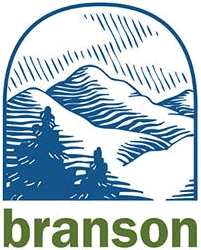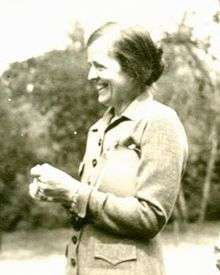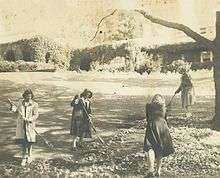The Branson School
The Branson School (also known as Branson, Branson School, or KBS) is a co-educational college-preparatory high school for students in grades 9–12. The school has 320 students, and is located in Ross, California, 11 miles north of San Francisco.
| The Branson School | |
|---|---|
 | |
| Location | |
39 Fernhill Avenue , | |
| Information | |
| Type | Independent, College-prep |
| Motto | Beauty is Truth - Truth Beauty "Small, but Mighty" |
| Established | 1920 |
| CEEB code | 052695 |
| Principal | Christina K. Mazzola |
| Faculty | 51 |
| Grades | 9–12 |
| Enrollment | 320 |
| Average class size | 13 students |
| Student to teacher ratio | 6:1 |
| Campus | Suburban, 17 acres (0.069 km2) |
| Color(s) | Blue and Green ( and ) |
| Mascot | Bulls |
| Information | 415-454-3612 |
| Website | http://www.branson.org |
History
Origins
In 1916, a group of 15 families in Marin County, California, pooled resources to start a local private school. The Little Gray School was finished in 1917 on the Cochrane Estate in San Rafael, California, next to what is now the San Rafael Public Library. The school began as a coeducational primary school, for students in grades 1–4. In 1918, the school added intermediate and upper levels, both of which were limited to girls, and was renamed the San Rafael School for Girls.[1]

In April 1920, the school's trustees appointed two co-headmistresses, Katharine Fleming Branson and her sister Laura Elizabeth Branson. The elder of the two sisters, Katharine Fleming Branson was Associate Director of Studies at the Beard School in Orange, New Jersey. Laura Elizabeth Branson was a teacher of mathematics and science at The Shipley School in Bryn Mawr, Pennsylvania, and had formerly served as head of the Department of Mathematics at Rosemary Hall in Greenwich, Connecticut. Both sisters were cum laude graduates of Bryn Mawr College.
On September 6, 1920, The Katharine Branson School officially opened, with 54 students enrolled in grades 1–11. The following year, the school added a kindergarten and a 12th grade, and in 1922 moved to its present campus in Ross, California. At its inception, the school included boys in the lower grades, but in the ensuing years the lower grades were discontinued, and the school became a boarding school for young women. In 1959, the Katharine Branson School became a secondary school for both day and boarding students.

In 1972, the school's board of trustees established Mount Tamalpais School, a day school for boys on the Katharine Branson School campus. MTS, with the same academic standards and basic philosophy as KBS, also shared a common board of trustees, faculty, and administrative staff. The boys' school used the upper part of the Katharine Branson School campus for their first years in operation, while the girls' classes took place on the lower part of the campus.
In January 1978, after extensive deliberation, the trustees decided to accept no further applications from boarding students, making 1981 the final year with boarding students.
Coeducation
The division of the two schools by gender started to become obsolete by the 1980s, as the two schools shared faculty, trustees, and curriculum. In July 1985, The Katharine Branson School and the Mount Tamalpais School were finally merged into one coeducational private day school, under the name The Branson School. Today the school is approximately evenly composed of boys and girls.
Campus Facilities
Academic facilities
- The Tallant Science Center is home to most science classes at Branson. The center is 6,000 square feet, and contains science labs, prep spaces and storage rooms.
- New Oaks contains most of the mathematics and language classes at Branson.
- Study Hall is composed of English and History classrooms, and a computer lab.
Athletic Facilities
- The Athletics Center at Branson contains two gyms and a workout facility.
- The Tom Ryan Field is a full-size turf field dedicated to Branson Soccer Coach Tom Ryan.
The Gym at Branson has a new court and an old court
Student facilities
- The Academic Quad is an open quadrangle surrounded by most of the classrooms at the school.
- The Jewett Theater is a theater used for plays and assembly.
- The Student Commons is an LEED Platinum-certified common area for students.[2]
- The Rand Center is a center committed to providing a learning resource for students; the center is dedicated to Allen Rand.[3]
Notable alumni
- Julia Child ('30) - chef, television personality, and author of Mastering the Art of French Cooking
- Tony Hsieh ('91) - internet entrepreneur and venture capitalist, CEO of Zappos
- Jonny Moseley ('93) - freestyle skier and television presenter, won gold medal in moguls at the 1998 Nagano Winter Olympic Games
- Zio Ziegler ('06) - painter and muralist
- Elisabeth Leamy - television journalist, author and speaker, investigative correspondent for The Dr. Oz Show
- Michael Froman ('80) - lawyer and politician, served as the U.S. Trade Representative since 2013
- Jennifer Siebel ('92) - documentary filmmaker and actress, director, writer and producer of the film Miss Representation
- Edie Sedgwick (left '56) - socialite, actress, model, and 'It' girl of 1965 (briefly attended, transferred)[4]
- Jack Conte ('02) - CEO and co-founder of Patreon, and singer and instrumentalist in Pomplamoose
- R. David Edelman ('03) - American policymaker and Special Assistant to President Barack Obama for Economic and Technology Policy
- Javier Zamora ('08) - Salvadoran-American poet and activist[5]
References
- "Our History / Branson's History". Branson School Website. The Branson School. Retrieved December 22, 2015.
- "Green could lead to platinum for Branson School". www.marinij.com. Retrieved 2015-12-23.
- "The Rand Center, Committed to Accommodations * The Yale Center for Dyslexia & Creativity". dyslexia.yale.edu. Retrieved 2015-12-23.
- Ray, Justin (July 24, 2013). "25 Things You Didn't Know About Edie Sedgwick". Complex. Retrieved December 22, 2015.
- https://www.marinij.com/2017/11/29/salvadoran-born-poet-speaks-to-refugee-traumas/